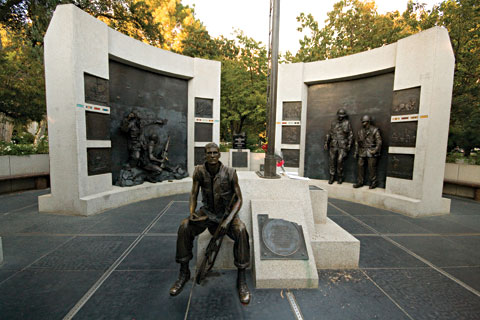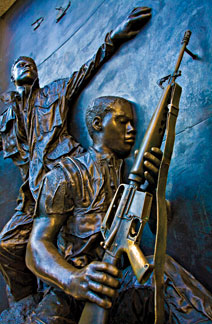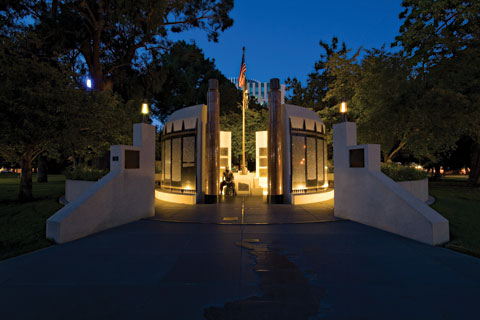 |
||||||||||||
|
May/June 2014
BY PAUL ROGERS The California Vietnam Veterans Memorial is so much more than names on a wall. Three-dimensional in concept and design, it vividly depicts myriad facets of the Vietnam War—from combat and injury to comradeship and loneliness—while recognizing not only all branches of the U.S. armed forces, but oft-overlooked participants, including prisoners of war and women. The memorial is dedicated to the 5,822 Californians who died in or remain missing from the Vietnam War—10 percent of the 58,000 Americans who died in the conflict. It also honors every man and woman who served in the war. This profoundly moving and uniquely engrossing window into the sacrifices of California’s veterans began as the vision of a handful of determined Vietnam veterans in the early 1980s. Herman “Woody” Woods first approached California Assemblyman Dick Floyd with the notion of a California-specific Vietnam memorial. With grassroots support whipped-up by Woods, Floyd authored Assembly Bill 650, which established the California Vietnam Veterans Memorial Commission. This legislation, which was signed into law by California Gov. George Deukmejian in 1983, granted permission for a memorial but without providing funding. It took five years to raise the $2.5 million (in 1988 dollars) needed to create the memorial, which was built entirely from donations. Charismatic Green Beret Brien Thomas “B.T.” Collins was central to this Herculean effort. Like Woods, Collins was a double amputee, having lost his right arm and leg to a grenade in the Mekong Delta in 1967. Despite his injuries, he went on to serve two terms as a Republican California State Assemblyman. Collins’s ability to rally support for the California Vietnam Veterans Memorial, prying open the checkbooks of major corporations and regular citizens alike, was the driving force behind its dedication on December 10, 1988. “He could make a grown man cry,” recalled Assemblyman Floyd in the program for the memorial’s twentieth anniversary in 2008. “When he pointed his hook into an audience and shared his and thousands of other Vietnam veterans’ stories, no one could say no.”
A visit to the California Vietnam Veterans Memorial is an emotional, enveloping experience. Nestled in the tranquil northeast corner of Sacramento’s elegant State Capitol grounds, it consists of two concentric walls, each broken into a pair of curved brackets. At the entrance to the monument, a detailed bronze map of South Vietnam is inlaid among the paving stones, giving context to the multiple scenes depicted within. The memorial’s low external wall includes stone benches facing the thousands of names of the fallen etched into twenty-two black granite panels, each looming above head-height on the outer face of its inner wall. “The memorial shows, by city in California, the name of each person who was killed, his age, rank, and branch of service,” said Jerry Yamamoto, an at-large member of VVA’s National Board of Directors who chaired the memorial’s twentieth anniversary ceremony program. “Some of the other memorials don’t—they just have the names listed.” Visitors to the memorial often look for names from their hometowns. Learning about casualties from familiar places can make their loss more relevant, while reading the ages of the fallen, most of whom were in their late teens or early twenties, is tragically sobering. Two hundred and fifty-one of the names are preceded by a gold star. Those men are officially missing in action or were killed, but their remains have not been recovered.
In counterpoint to these relatively flat panels are four full-size, three-dimensional bronze reliefs that emerge from among them, along with the single statue that sits alone at the memorial’s heart. These were the brainchild of California sculptor Rolf Kriken, a Vietnam-era veteran who created all of the monument’s bronze work. “When I went to the memorial and the walls were up, I realized that really all of the flat-plane work that I had done, or was conceiving to do, for those panels was very limited,” said Kriken, speaking from his foundry in Kelseyville, Calif. “So I basically pulled the figures out from the wall and made them life-size and dimensional.” Entering the center of the memorial through a pair of stone light pylons that resemble huge shell casings, visitors are immediately drawn to Kriken’s statue of a seated soldier, fresh from a firefight, clutching a letter from his parents. “He’s just twenty, and they’re going to have a barbecue for him, and he’ll be home in less than forty-eight hours,” Kriken, who served as an Army cryptologist, recon tank driver, and forward air controller, explained. “And it’s like, ‘How am I going to relate?’ ” The inclusion of the letter acknowledges the impact of the Vietnam War on those at home. “Beyond the people who served, you also have to look at what their families are going through and understand that there are many family members involved in the process of trying to help veterans heal,” said Yamamoto, who served as an Army social work psychology specialist from 1966-68 and is president of VVA Chapter 53 in Redondo Beach. The statue sits beneath the Stars and Stripes and the POW/MIA flag fluttering from a pole that mimics a warship’s radar mast. Next to it is a bronze plaque bearing the poetry of posthumously decorated Maj. Michael O’Donnell:
“It was the last stanza of a poem, and then he was killed on a rescue mission [in Cambodia, in 1970] three months after he wrote that,” said Kriken, who has also created bronzes for war memorials in Danville, California, and Madras, Oregon, and has been awarded a contract for the planned Cleveland All Veterans Memorial in Ohio. The four bronze high reliefs, in part based on photographs, portray a female nurse tending to a severely wounded soldier; dramatic combat south of Con Thien Marine Corps base; a pair of comrades walking together; and a forlorn, head-shorn prisoner of war (created by Kriken with input from a former POW). The bracketing walls and multiple images of the Sacramento memorial put visitors within the Vietnam experience—not just looking at it, but briefly existing in it. “Most memorials are just a stone wall with names etched on,” said VVA Region 9 Director Dick Southern, who served on the Memorial’s Twentieth Anniversary Committee. “This actually has statues depicting various phases of the war, including POWs—which most monuments don’t even think about.”
Lit by night, in part by electric lamps representing eternal flames, the California Vietnam Veterans Memorial is open to visitors ’round-the-clock, year-round. It’s busiest in the summer months, when hundreds pass through daily. But even on a chilly winter workday, passers-by regularly pause at the monument. In the springtime adjacent trees burst into bloom, framing the memorial. Substantial crowds and eminent speakers, including politicians and veterans, gather at the memorial to mark significant anniversaries. The most recent, the twenty-fifth anniversary re-dedication in November, included a 300-rider motorcycle run and a ceremony in honor of POWs and MIAs. An especially moving annual event at the monument is the “Reading of the Names,” held on the day before Memorial Day. The time it takes to read aloud the names of all California’s fallen—twelve hours— underscores the scale of the state’s loss. “I’ve read names there myself, and it’s a moving experience,” said Southern, who served as an Army medic from 1966-68. “It gets harder and harder as you go down the list.” The memorial conjures a broad range of emotions. “From smiling to crying—all the way through,” said Southern, one of many VVA members actively involved with the monument. “It brings back memories and connects veterans with their past.” More vividly than most, the Sacramento memorial serves not only to commemorate but also to educate post-Vietnam generations about the reality of the war—even more so as the conflict slips further into the past. Echoing the blank stare of its lonesome POW statue, the monument never blinks from portraying rather than glorifying the war, from the bandaged stump of an amputee to the mud-sucking of weary soldiers’ boots. “It’s a real sanctuary; it’s a real special place,” Kriken said. “It just has some tremendous healing energy, as well as raising consciousness.”
|
||||||||||||
|
|
||||||||||||
|
||||||||||||
8719 Colesville Road, Suite 100, Silver Spring. MD 20910 | www.vva.org | contact us |
||||||||||||











 >The interior of the memorial’s inner wall is clad with bronze panels based on well-known photographs from the Vietnam War. These include “Medical Corpsman Runs with Wounded Baby” from Life magazine, “Tunnel Rat” from Stars and Stripes, and “Boeing B-52 Arc Light Bombing Mission,” based on a U.S. Air Force photograph. Images of service ribbons punctuate the somber walls.
>The interior of the memorial’s inner wall is clad with bronze panels based on well-known photographs from the Vietnam War. These include “Medical Corpsman Runs with Wounded Baby” from Life magazine, “Tunnel Rat” from Stars and Stripes, and “Boeing B-52 Arc Light Bombing Mission,” based on a U.S. Air Force photograph. Images of service ribbons punctuate the somber walls.